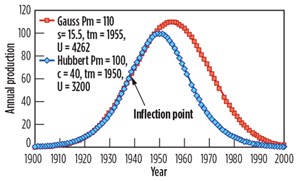What's New in Exploration
Geophysicist M. King Hubbert predicted rightly in 1956 that oil and gas are finite. However, the planet’s oil and gas production did not peak five years later, as he worried. USGS data suggested a peak in 1971, with a current strong rising trend from shale. Hubbert and others used a statistical bell curve approach to define what he, and everyone else, could not know about the future, Fig. 1. Former U.S. President Jimmy Carter believed that the Hubbert Peak had occurred, and that world production was somewhere on the back side of a skewed curve. He instituted a windfall profits tax on the U.S. industry in the late 1970s, just to make it so. Every governmental energy policy since then has followed that curve.

A recalibration. Historical re-calibrating of global reserves is reshaped by unconventional production. I explain horizontal production thusly. A vertical 9-in. well, penetrating 30 ft of 200-millidarcy sand, will commonly have perforations over about 20 ft. It will “draw” from the wellbore rock to somewhere “out there,” a radial distance usually no more than 500 ft, i.e. 18 acres. A horizontal in the same sand will have 10,000 ft of pay, with say 26 sets of 20-ft perfs spaced along the casing, draining about the same feet vertically and horizontally with overlap. So, why is anyone surprised when better than eight years of vertical-equivalent production occurs in one year from a horizontal, and the horizontal well draws down in under one year?
Since SEC reporting is annual, a conundrum is created, whereby keeping booked reserves constant requires unconventional drilling to become like a Ponzi scheme. Use today’s cash for urgent ongoing drilling to keep the book full, or lose share value. Then, to “help,” we frac everything for more efficient drainage, making the decline curve steeper. The impact on overall break-even (BE) is severe, since demand for rigs and trucks goes over the moon. Often, BE is way past $60/bbl.
When we thought we were rich at $70 oil, regulators accused us of disposing too much water. Folks in Oklahoma can show that frac water injection caused 290-million-to-1.4-billion-year-old rock (depending on who you talk to) to wake up and shake a bit. Unfortunately, that occurred under some houses. Rightly, we can no longer deny this occurs, but we realize that only 20% of fracing improves production of oil, using the 80/20 rule. Much worse, SPE studies indicate that maybe only 8% of fracs produce.
The SEC doesn’t much care about which frac is working, if the total at the wellhead is reported. Companies care about the amount of water that is being produced to keep hydrocarbon production coming to that book. Eliminating unnecessary fracing is an accountant’s dream, which cannot be determined until the frac is created and individually tested.
Enter the need for new exploration tech. Conventional exploration tools are our foundation, but where, and how, to build on them has been less than consistent. Success depends on integrating technologies of engineering, geology and geophysics. SEG/SEAM, “Life of Field,” in my opinion, is the best way forward to have a conversation that will greatly help extend field life onshore, and, most importantly, in the high-cap offshore.
SEAM Life of Field has only seven paying participants. Think this: Your tool set may help you indirectly assess detectable movable fluids, but, that is not what occurs in unconventional shale reservoirs. If you need to frac, oil was not “movable” within the definition of conventional seismic resolution. SEAM needs more funding.
Therefore, technology like cross-well, and high-resolution 3C VSP, and active-source vector surface detection, are getting another look within all wave forms. A DOE grant with Paulsson, Fluidion and Southwestern, using seismic energy added to proppant, is showing significant promise. Microseis VSP in a wellbore to determine frac efficiency is also being tested. VSP in horizontals, combined with scalar micro-seismic tools, was tested successfully by Range Resources, GTI and DOE in 2009. Results should be better today with increased sample density, low-amplitude phones and actual vectors.
However, each time something new comes along, risk-takers have issues. For example; I was asked to “expert” comment in a lawsuit brought by an investor, on whether an exploration company should have shot new 3D in a program versus the 2D they did shoot. Everybody knew by then about 3D, and how to spell it in their brochures. The 2D interpretation and subsequent drilling were non-commercial.
The argument, post-drill, from the investor was, of course, the oil company should have used new 3D. The location—the marine near-shoreline of the Cook Inlet, with 35-ft-plus tides! The investor was focused on totally wrong issues, thinking that cheaper 2D would garner the same results as 3D, even though 3D would cost more than four times the price of 2D. The AFE bottom line always counts, but it is how you get there, and what you are willing to do to achieve the best outcome, that determines the resulting revenue. Only a few hundred-thousand people are finding oil and gas. The rest just drive cars. I did not get paid for my response. ![]()

- Applying ultra-deep LWD resistivity technology successfully in a SAGD operation (May 2019)
- Adoption of wireless intelligent completions advances (May 2019)
- Majors double down as takeaway crunch eases (April 2019)
- What’s new in well logging and formation evaluation (April 2019)
- Qualification of a 20,000-psi subsea BOP: A collaborative approach (February 2019)
- ConocoPhillips’ Greg Leveille sees rapid trajectory of technical advancement continuing (February 2019)


